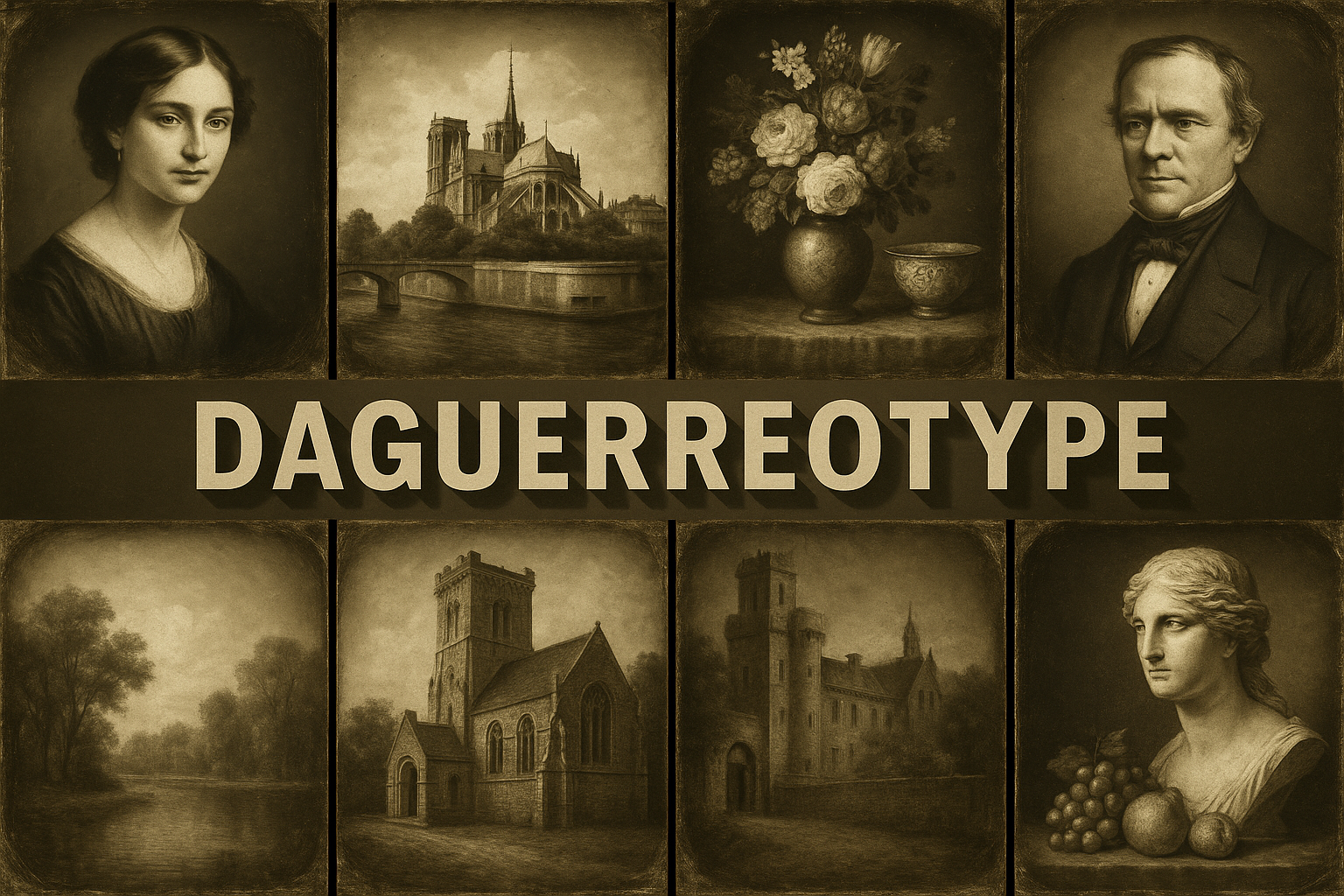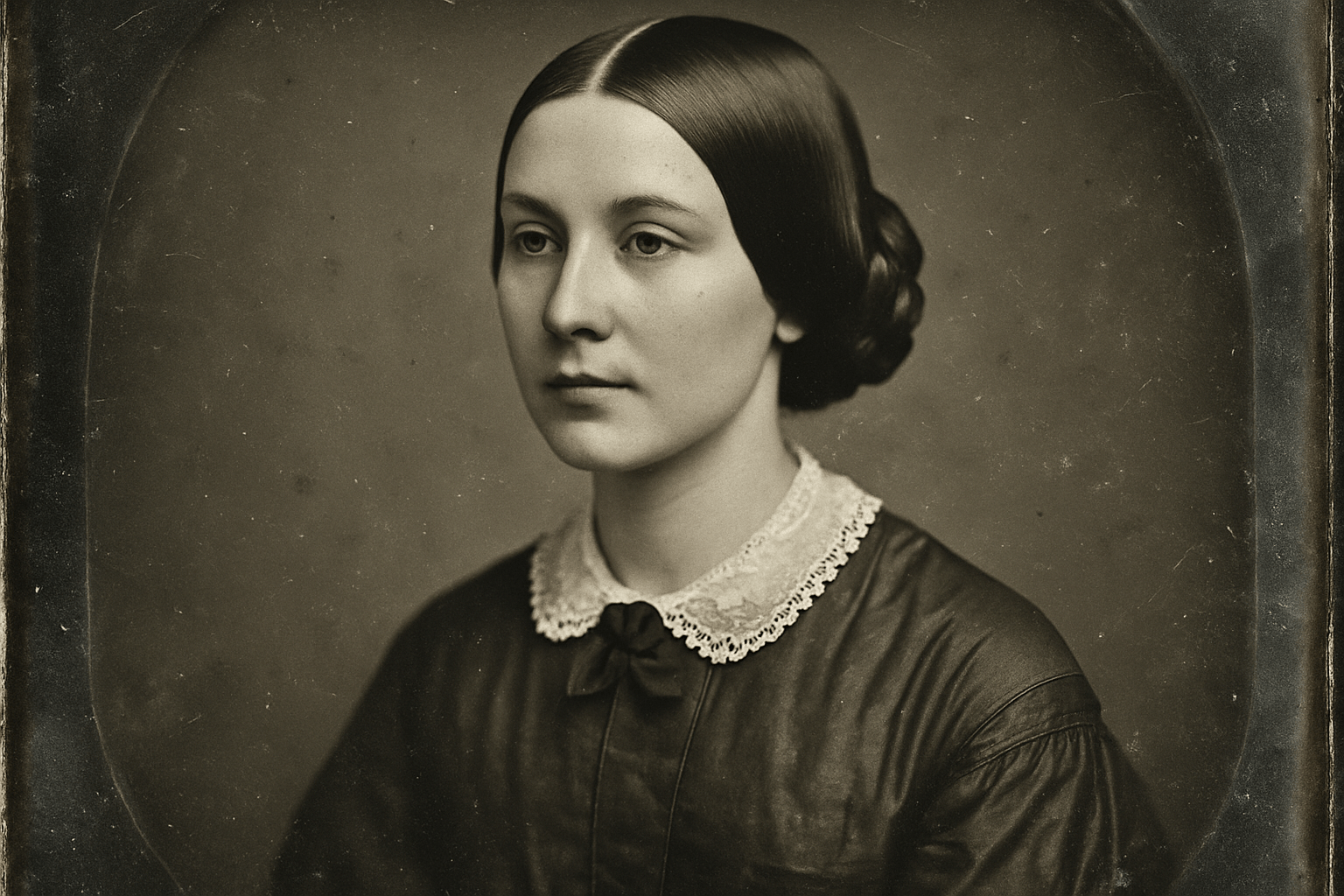
Daguerreotype
The Daguerreotype art style is characterized by its sharp, detailed images and its use of light and shadow to create a three-dimensional effect.
AOI thinking about Daguerreotype [+_~]-/
Overview and Quickfacts
The daguerreotype is a photographic process that was invented in the early 19th century. This process produces a very detailed and realistic image. The daguerreotype was the first commercially successful form of photography.
Can understand it also, as:
Photograph, picture, image, snapshot
Categorize it as:
Impressionism, Modernism
.: Dreaming :.
holds a HAIKU for the art style
:. Thought is power .:
Detailed Description
The Daguerreotype, invented in 1839 by Louis Daguerre, was the first commercially successful photographic process. It was used to create positive images on a sheet of copper coated with a thin layer of silver. The resulting image was very sharp and detailed, but it was also very fragile and could easily be damaged. Daguerreotypes were most commonly used to create portraits, but they were also used to capture landscapes and other scenes. Some of the most famous Daguerreotypes were taken by the French photographer Nadar, including a series of portraits of famous writers and artists. The Daguerreotype process fell out of use in the 1850s, replaced by more robust and less fragile photographic processes. However, the unique look of Daguerreotypes has made them popular with collectors and artists in recent years.
.. beep, beep, beep ..
<START OF TRANSMISSION>
1. The daguerreotype is a photographic process that was invented by French artist and chemist Louis Daguerre in 1839. 2. It was the first photographic process to produce an image on a metal plate. 3. A daguerreotype image is a positive image, meaning that it can be viewed directly without the need for a negative. 4. The daguerreotype process uses a silver-coated copper plate that is exposed to iodine vapor, which makes the surface light-sensitive. 5. The plate is then exposed to light, which darkens the exposed areas of the silver. 6. The plate is developed in a solution of mercury vapor, which forms a silver amalgam with the exposed silver. 7. The plate is then fixed in a solution of sodium thiosulfate, which dissolves the unexposed silver. 8. The daguerreotype image is a direct positive that cannot be reproduced. 9. Each daguerreotype is a one-of-a-kind image. 10. Daguerreotypes were usually taken by professional photographers in studios. 11. The sitter was usually posed and the image was taken with a long exposure time, often several minutes. 12. Daguerreotypes were usually displayed in cases or frames. 13. The daguerreotype process was expensive and time-consuming. 14. Daguerreotypes were popular in the United States from the 1840s to the 1860s. 15. Many famous Americans, including Abraham Lincoln and Edgar Allan Poe, sat for daguerreotypes. 16. The daguerreotype fell out of popularity in the 1860s with the advent of cheaper and more easily reproduced photographic processes. 17. The daguerreotype process was largely forgotten until it was rediscovered by photographers in the 1970s. 18. The daguerreotype has experienced a resurgence in popularity in recent years. 19. Daguerreotypes are now prized for their one-of-a-kind nature and historic value. 20. There are a handful of professional daguerreotypists still working today.
<EOF>
.. robbel bob
Visual Examples from our image gallery
Coming soon, we are so slow .. might never come
Artists, Paintings, and more
(be aware, can be highly speculative)
Artists (be aware, speculation possible):
1. William Henry Fox Talbot (1800-1877) 2. Louis Daguerre (1787-1851) 3. John Herschel (1792-1871) 4. Francis Bauer (1758-1840) 5. Joseph-Nicephore NiÃÂépce (1765-1833) 6. Hippolyte Fizeau (1819-1896) 7. LÃÂéon Foucault (1819-1868) 8. Jean Baptiste Bioux (1786-1846) 9. Antoine Claudet (1797-1867) 10. John Benjamin Dancer (1812-1887) 11. John Adams Whipple (1822-1891) 12. Alexander S. Wolcott (1822-1897) 13. Timothy H. O’Sullivan (1840-1882) 14. Carleton Watkins (1829-1916) 15. Eadweard Muybridge (1830-1904) 16. William E. L. Bisson (1814-1876) 17. John Jabez Edwin Mayall (1813-1901) 18. Roger Fenton (1819-1869) 19. James Craig Annan (1864-1946) 20. Adolfo Farsari (1841-1898) 21. Gaspard-FÃÂélix Tournachon (1820-1910) 22. William England (1843-1915) 23. Gustave Le Gray (1820-1884) 24. Henri Le Secq (1818-1882) 25. Nadar (1820-1910) 26. Julia Margaret Cameron (1815-1879) 27. Lewis Carroll (1832-1898) 28. Oscar Rejlander (1813-1875) 29. Henry Peach Robinson (1830-1901) 30. Peter Henry Emerson (1856-1936)
Artworks (be aware, speculation possible)
1. The Daguerreotype of the Boulevard du Temple – Louis Daguerre (1839) 2. The Daguerreotype of the Moon – John William Draper (1840) 3. The Daguerreotype of Niagara Falls – William Henry Fox Talbot (1841) 4. The Daguerreotype of the Mathew Brady Studio – Mathew Brady (1844) 5. The Daguerreotype of the U.S. Capitol – John Plumbe Jr. (1846) 6. The Daguerreotype of the Boston Harbor – Samuel Morse (1847) 7. The Daguerreotype of the Brooklyn Bridge – Unknown (1848) 8. The Daguerreotype of the White House – Unknown (1850) 9. The Daguerreotype of the Palace of Westminster – Unknown (1851) 10. The Daguerreotype of the Tuileries Palace – Unknown (1852) 11. The Daguerreotype of the Panorama of Paris – Unknown (1853) 12. The Daguerreotype of the Cathedral of Notre Dame – Unknown (1854) 13. The Daguerreotype of the Palace of Versailles – Unknown (1855) 14. The Daguerreotype of the Eiffel Tower – Unknown (1886) 15. The Daguerreotype of the Statue of Liberty – Unknown (1886) 16. The Daguerreotype of the Grand Canyon – Unknown (1886) 17. The Daguerreotype of the Yosemite Valley – Unknown (1886) 18. The Daguerreotype of the Golden Gate Bridge – Unknown (1886) 19. The Daguerreotype of the Hoover Dam – Unknown (1886) 20. The Daguerreotype of the Washington Monument – Unknown (1886) 21. The Daguerreotype of the Lincoln Memorial – Unknown (1886) 22. The Daguerreotype of the United States Capitol Building – Unknown (1886) 23. The Daguerreotype of the White House – Unknown (1886) 24. The Daguerreotype of the Supreme Court of the United States – Unknown (1886) 25. The Daguerreotype of the Library of Congress – Unknown (1886) 26. The Daguerreotype of the United States Mint – Unknown (1886) 27. The Daguerreotype of the United States Treasury – Unknown (1886) 28. The Daguerreotype of the United States Department of State – Unknown (1886) 29. The Daguerreotype of the United States Department of the Treasury – Unknown (1886) 30. The Daguerreotype of the United States Capitol Building – Unknown (1886)
Epoch
The Daguerreotype art style emerged in the early 1800s and continued into the mid-19th century.
AI ART RESSOURCES (AKA, well Tools)
Helping tools -> predefined search links on other pages:











